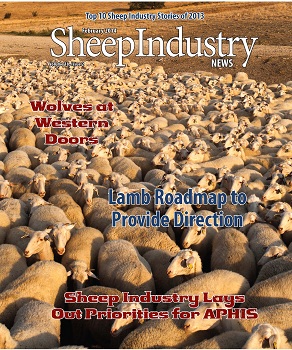
- February 2014
- President’s Notes
- Market Report
- American Lamb Industry Announces Final Roadmap
- Looking Back: Top 10 Sheep Stories of 2013
- Sheep to Shawl
- Sheep Growing Senator Weighs in on Idaho Wolf Debate
- Are Your Ewes Pregnant?
- Economist Sees Bumpy Years for U.S. Ag
- New Farm Bill May Bring Insurance Issues
- New Wool Yarn Mill Filling Niche
- College Wool Judging Teams Pick Up Skills Together at Belle Fourche Clinic
- ASI Offers Sheep Priorities to APHIS
- Utah Farm Bureau: States Can Manage Wolves
- Farmland Prices Rise, But How Long is Ride?
- Sheep Heritage Contributors
- Obituaries
College Wool Judging Teams Pick Up Skills Together at Belle Fourche Clinic
Milo Dailey
Butte County Post
Why bring students to Belle Fourche from Northern Plains state universities to learn how to judge wool in competition at the Denver Stock Show?
Dave Ollila, South Dakota State University sheep field specialist from Newell, said Belle Fourche and Butte County have resources that are well known to sheep and wool people all over the world.
One of those resources is Larry Prager, general manager of Center of the Nation Wool.
The Tri-State Collegiate Wool Judging Clinic had students and faculty from North Dakota State University at Fargo, Montana State University at Bozeman, and South Dakota State University at Brookings.
“All the states are working together to help them for the Denver national Winter Stock Show,” Ollila said during the clinic, which preceded the January show in Denver.
The 17 students looked over fleeces of varying quality that Prager brought to the Community Hall in downtown Belle Fourche for the program.
“Larry’s the best expert,” Ollila said. He added that Prager’s skills and knowledge were even helping him when he was a college student.
That’s why Belle Fourche hosts the clinic.
The Tri-State area has the climate and grasses, sheep ranchers and sheep breeds to give the world some of its best quality wool in quantity, Ollila said.
The thickness of the wool strands and length make a difference in its ability to be spun into high value textiles.
Judging the fleeces also includes how clean the wool is, and its color.
Lisa Surber of MSU also brought her department’s wool quality testing machine as a way to help students see the lab work backing up a good wool judge’s experience and feel for the fleeces.
It can analyze the thickness of the wool well enough even to give students information on the sheep’s diet through the year from shearing to the next shearing.
The machine is from Australia, a major competitor for American wool.
“There are only five in the U.S.,” Surber said. The portable unit can be used in the lab or can be taken to a shearing to get immediate feedback on the wool quality.
Ollila said Belle Fourche is a center of top quality wool country that extends into southwest North Dakota, the Montana plains and Wyoming as well as northwest South Dakota.
Also on hand at the clinic to help the program was longtime top-ranked sheep shearer and sheep raiser Wade Kopren of Bison.
That’s to help encourage young people to get into the sheep business that is shrinking in the United States.
Dwindling numbers of sheep are putting the American wool industry at risk as markets in the nation collapse.
The wool and sheep industry are working together to promote the industry from the prairie to operations like Center of the Nation Wool and manufacturing businesses.
“It becomes a collaborative effort,” Ollila said.
Judging clinics such as the college seminar in Belle Fourche will help in the long run for producers to get an increasingly high quality product to market.

